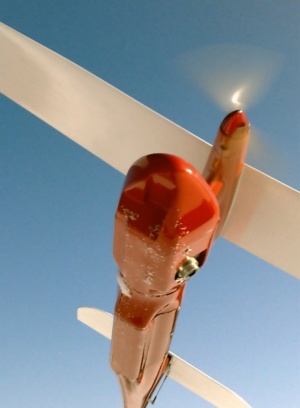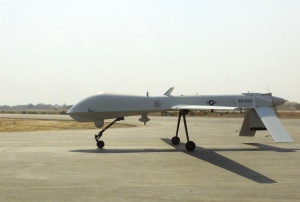If you wish to contribute or participate in the discussions about articles you are invited to contact the Editor
Autonomous Flying: Difference between revisions
Gema.Cueto (talk | contribs) |
|||
| (8 intermediate revisions by 5 users not shown) | |||
| Line 1: | Line 1: | ||
{{Article Infobox2 | {{Article Infobox2 | ||
|Category=Applications | |Category=Applications | ||
| | |Editors=GMV | ||
|Level=Intermediate | |||
|Level= | |||
|YearOfPublication=2011 | |YearOfPublication=2011 | ||
|Logo=GMV | |Logo=GMV | ||
}} | }} | ||
Advanced UAVs (Unmanned Aerial Vehicles) are used or proposed in many missions covering security (including border patrol, anti-drug warfare, chemical, biological and radiological detection, maritime vessel identification and interdiction), surveillance of infrastructures (pipelines, power lines, railways, waterways, roads, airports), search and rescue, mapping, fisheries, agriculture, forestry, natural resource monitoring, fire fighting and emergency management, airborne communication collection and relay, weather data collection, environmental monitoring, pollution detection and other scientific research<ref> Feasibility Study for an Unmanned Aerial System Mission Supported by Integrated Space Systems, ESA Portal, July 2009</ref>. | |||
GNSS plays a very important role in UAVs. Either when guided autonomously or guided by ground-based pilots, the determination of the location and speed of the UAV either for navigation or georeferencing the collected data is usually done by GNSS. If the vehicle is autonomous, GNSS can contribute actively to the control loop of the UAV by providing inputs to the control algorithm and by giving feedback to the control algorithm after an action is taken. | |||
GNSS plays a very important role in UAVs. Either | |||
== Application Architecture == | == Application Architecture == | ||
| Line 16: | Line 14: | ||
[[File:Pteryx UAV - wiki.jpg|right|thumb|300px|Pteryx UAV used for aerial surveys]] | [[File:Pteryx UAV - wiki.jpg|right|thumb|300px|Pteryx UAV used for aerial surveys]] | ||
The characteristics and installation of the GNSS receivers in UAVs can vary with the type of UAV and how the the UAV uses the GNSS information. For larger UAVs the equipment and installation can be similar to the equipment | The characteristics and installation of the GNSS receivers in UAVs can vary with the type of UAV and how the the UAV uses the GNSS information. For larger UAVs the equipment and installation can be similar to the equipment built for conventional airplanes (except for the user interface). For smaller UAVs there might be the need to have tailored GNSS receivers based on existing off-the-shelf equipment due the reduced size of the aircraft. | ||
Typically the installation will consist of one antenna installed on the upper part of the aircraft connected to the receiver that is then connected to the avionics of the UAV where the GNSS data can be integrated with other sensors data. If GNSS data is used for attitude determination a multiple antenna configuration might be in-place usually with up to 3 antennas usually installed on the tip of the wings and on the tail. | Typically the installation will consist of one antenna installed on the upper part of the aircraft connected to the receiver that is then connected to the avionics of the UAV where the GNSS data can be integrated with other sensors data. If GNSS data is used for attitude determination a multiple antenna configuration might be in-place usually with up to 3 antennas usually installed on the tip of the wings and on the tail. | ||
| Line 24: | Line 22: | ||
[[File:US Navy 020214-M-7370C-034 UAV.jpg|right|thumb|300px|Predator UAV]] | [[File:US Navy 020214-M-7370C-034 UAV.jpg|right|thumb|300px|Predator UAV]] | ||
In UAVs, GNSS can be used for 4 different types of applications<ref>[ | In UAVs, GNSS can be used for 4 different types of applications<ref>[https://www.septentrio.com/ GNSS positioning for UAV Applications], Jan Leyssens, Septentrio</ref>: | ||
* '''Navigation''' - The use of GNSS in the navigation of UAV is similar to the | * '''Navigation''' - The use of GNSS in the navigation of UAV is similar to the one in [[En Route Navigation|manned aerial vehicle navigation]]. Two main differences can be observed: | ||
** Safety requirements are less stringent since the loss of the vehicle doesn't imply the loss of human lives or injuries. Anyhow safety requirements must still be taken into account as described below. | ** Safety requirements are less stringent since the loss of the vehicle doesn't imply the loss of human lives or injuries. Anyhow safety requirements must still be taken into account as described below. | ||
** In autonomous UAVs, GNSS is part of the control loop of the guidance algorithm, although other sources such as cameras, inertial sensors are normally | ** In autonomous UAVs, GNSS is part of the control loop of the guidance algorithm, although other sources such as cameras, inertial sensors are normally also integrated and combined by filters with GNSS data to guide the vehicle. | ||
* '''Attitude Determination''' - Attitude determination can be | * '''Attitude Determination''' - Attitude determination can be done by UAVs in the same way as in [[Attitude Determination|manned aerial vehicle attitude determination]] | ||
* '''Georeferencing data''' - As described, UAVs can be | * '''Georeferencing data''' - As described, UAVs can be deployed for different types of activities. The main type of payload is earth observation payload to conduct [[Aerial Survey|aerial surveys]] where different techniques (cameras, radars, lidars,...) are used to monitor or collect information from the earth surface. For this information to be useful needs to be georeferenced and this is normally done with GNSS. | ||
* '''Safety''' - Although self-preservation is less relevant in an unmaned aerial vehicle is still very important that UAVs don't interfere with maned vehicles and that don't cause loss of lives or property damage when they land or crash. Therefore the use of [[Air Traffic Control#Airborne Surveillance Systems (ADS-B)|ADS-B transponders]] on UAVs will allow traffic controllers, other UAVs and maned aerial vehicles to be aware of their presence. | * '''Safety''' - Although self-preservation is less relevant in an unmaned aerial vehicle is still very important that UAVs don't interfere with maned vehicles and that don't cause loss of lives or property damage when they land or crash. Therefore the use of [[Air Traffic Control#Airborne Surveillance Systems (ADS-B)|ADS-B transponders]] on UAVs will allow traffic controllers, other UAVs and maned aerial vehicles to be aware of their presence. | ||
== Application Examples == | == Application Examples == | ||
The number of UAVs in operation is too big to list here<ref>[[Wikipedia:List of unmanned aerial vehicles|List of UAVs from Wikipedia]]</ref>. Most of the UAVs currently on operation uses GNSS. | The number of UAVs in operation is too big to list here<ref>[[Wikipedia:List of unmanned aerial vehicles|List of UAVs from Wikipedia]]</ref>. Most of the UAVs currently on operation uses GNSS in some way. | ||
Some of the most known UAVs due to its involvement in the US operations in Afghanistan and Iraq are the [[SKYbrary:Predator B|Predator B]] and its successor the [[Wikipedia:General Atomics MQ-9 Reaper|Reaper]]. | Some of the most known UAVs due to its involvement in the US operations in Afghanistan and Iraq are the [[SKYbrary:Predator B|Predator B]] and its successor the [[Wikipedia:General Atomics MQ-9 Reaper|Reaper]]. | ||
Latest revision as of 11:32, 21 May 2021
| Applications | |
|---|---|
| Title | Autonomous Flying |
| Edited by | GMV |
| Level | Intermediate |
| Year of Publication | 2011 |
Advanced UAVs (Unmanned Aerial Vehicles) are used or proposed in many missions covering security (including border patrol, anti-drug warfare, chemical, biological and radiological detection, maritime vessel identification and interdiction), surveillance of infrastructures (pipelines, power lines, railways, waterways, roads, airports), search and rescue, mapping, fisheries, agriculture, forestry, natural resource monitoring, fire fighting and emergency management, airborne communication collection and relay, weather data collection, environmental monitoring, pollution detection and other scientific research[1].
GNSS plays a very important role in UAVs. Either when guided autonomously or guided by ground-based pilots, the determination of the location and speed of the UAV either for navigation or georeferencing the collected data is usually done by GNSS. If the vehicle is autonomous, GNSS can contribute actively to the control loop of the UAV by providing inputs to the control algorithm and by giving feedback to the control algorithm after an action is taken.
Application Architecture
The characteristics and installation of the GNSS receivers in UAVs can vary with the type of UAV and how the the UAV uses the GNSS information. For larger UAVs the equipment and installation can be similar to the equipment built for conventional airplanes (except for the user interface). For smaller UAVs there might be the need to have tailored GNSS receivers based on existing off-the-shelf equipment due the reduced size of the aircraft.
Typically the installation will consist of one antenna installed on the upper part of the aircraft connected to the receiver that is then connected to the avionics of the UAV where the GNSS data can be integrated with other sensors data. If GNSS data is used for attitude determination a multiple antenna configuration might be in-place usually with up to 3 antennas usually installed on the tip of the wings and on the tail.
Application Characterization
In UAVs, GNSS can be used for 4 different types of applications[2]:
- Navigation - The use of GNSS in the navigation of UAV is similar to the one in manned aerial vehicle navigation. Two main differences can be observed:
- Safety requirements are less stringent since the loss of the vehicle doesn't imply the loss of human lives or injuries. Anyhow safety requirements must still be taken into account as described below.
- In autonomous UAVs, GNSS is part of the control loop of the guidance algorithm, although other sources such as cameras, inertial sensors are normally also integrated and combined by filters with GNSS data to guide the vehicle.
- Attitude Determination - Attitude determination can be done by UAVs in the same way as in manned aerial vehicle attitude determination
- Georeferencing data - As described, UAVs can be deployed for different types of activities. The main type of payload is earth observation payload to conduct aerial surveys where different techniques (cameras, radars, lidars,...) are used to monitor or collect information from the earth surface. For this information to be useful needs to be georeferenced and this is normally done with GNSS.
- Safety - Although self-preservation is less relevant in an unmaned aerial vehicle is still very important that UAVs don't interfere with maned vehicles and that don't cause loss of lives or property damage when they land or crash. Therefore the use of ADS-B transponders on UAVs will allow traffic controllers, other UAVs and maned aerial vehicles to be aware of their presence.
Application Examples
The number of UAVs in operation is too big to list here[3]. Most of the UAVs currently on operation uses GNSS in some way.
Some of the most known UAVs due to its involvement in the US operations in Afghanistan and Iraq are the Predator B and its successor the Reaper.
Notes
References
- ^ Feasibility Study for an Unmanned Aerial System Mission Supported by Integrated Space Systems, ESA Portal, July 2009
- ^ GNSS positioning for UAV Applications, Jan Leyssens, Septentrio
- ^ List of UAVs from Wikipedia


